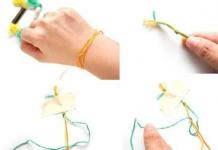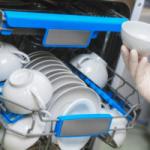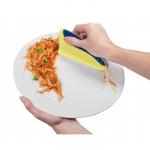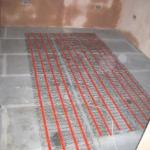Our review focuses on how to properly load dishes in the dishwasher.
The quality of washing depends not only on the reliability of equipment, a reasonably selected detergent and timely poured salt. How well the dishes will be washed also depends on their location in the bunker.
Preparing to download
Before placing plates on the shelves and compartments of the PMM, clean them of food debris. The better you do this, the higher the chance of avoiding clogged filters and drains.
On a note! Use paper towels or napkins, a damp sponge, or a rubber spatula, whichever is more convenient, to brush food off the plates. Make sure that there are no egg shells, fruit pits, grains left - these are the enemies of the drain system and provocateurs of blockages.

Do not know whether to rinse the plates before loading into the PMM? After rinsing, the washing quality improves. But the owners of the equipment are justifiably wondering why they need a machine if they need to be washed by hand. Therefore, there are models with the "Soak" or "Pre-wash" function. If there is no such option, you will have to soak the plates.
How to arrange cups, glasses and glasses
Glasses, mugs, cups and glasses need to get rid of tea, coffee, wine and other deposits. For fragile containers, a separate tray is provided, located on top of the hopper. Put them ONLY upside down - so the water will get inside and then drain down. Do not stack glasses or mugs (porcelain, crystal, glass) in a horizontal position, otherwise the washing effect will be zero.

Is it possible to put glasses close together so that they touch? Definitely not: wine glasses and glasses need to be fixed with a special mount - a holder. Without it, fragile products, even on a delicate program, can burst or break. Wine glass holders can also be used for small cups.

On a note! When sliding the tray, check how securely everything is fixed and arranged. Use fasteners and other accessories as needed.
How to arrange plates according to the rules
Depending on the size of the plates and their purpose, they can be placed in one of the trays - from above or below. If the volumes of your Bosch, Hansa, Electrolux dishwasher allow, you can place everything: bowls, gravy boats, salt shakers, etc.

When choosing a low-temperature mode, load plastic dishes on the top shelf - plates, trays, containers. So the “delicate” utensils will be away from the heating element, and the plastic will not melt.
The lower tray is used to load large and medium plates, including soup dishes. Place the widest plates on the edge, with a smaller diameter - closer to the center. This will ensure 100% water access to the very top of the bunker.

Place the dishes with the front part to the center of the basket, making sure that there are gaps. The greater the distance, the more efficient the washing process.

Important! Do not load "to the eyeballs" compact machine! If you manage to "shove" more than 5-6 declared sets, all this simply will not be washed off.
Cutlery: fold correctly
To load cutlery into the machine, find a small tray or basket inside the hopper. When laying out spoons and forks, alternate them so that they do not join together. Blades of knives should be directed strictly down.

In the latest PMM models, such as Bosch or Siemens, a top tray is allocated for cutlery. In such a compartment, spoons need to be laid out horizontally: the appliances are washed efficiently, and the space in the bunker is saved. In addition, the location of sharp instruments - knives and forks - in a horizontal position is the most successful in terms of safety.

Important! Do not load sharp and ceramic knives into the PMM. So you risk dulling the blades. This also applies to knives and utensils with a wooden handle (any wooden utensils cannot be washed in a typewriter).
Arrangement of large dishes
Large kitchen utensils in which food is cooked (pans, pots, saucepans, baking sheets, etc.) should be placed in the lowest basket. Wash them separately from glass, porcelain and crystal items: pots and pans require intensive washing, which fragile appliances will not endure.
Frying pans and baking sheets
Put them sideways. Place pots upside down or at a slight angle to allow water to flow all over the hopper. If the pans are turned upside down, water will not get into the upper tray, so follow the rules.


On a note! Is it possible to wash the pan in PMM (with a Teflon or other coating), the manufacturer indicates. If the permission icon is not found, do not risk it. Read about what can not be washed in the dishwasher, in a separate publication.
If there is a removable handle, disconnect it immediately. Place frying pans, ladles and stewpans with a handle especially carefully, without touching the walls of the tank or adjacent plates with it. If you see that the dishes clearly do not enter the hopper, wash them in parts. Use half load mode, if it is provided in the functionality of your PMM.
When placing baking sheets, try to place them sideways along the edges of the tray. If there is no special holder nozzle, follow the general location rules so that the sprinkler does not interfere with the water supply.

Small utensils: is it possible to wash and how
If you really want to wash a cutting board, a ladle, a slotted spoon or a spatula in a typewriter, this can be done - provided there are no wooden parts. Plastic spatulas, salad spoons, tongs, ice cream spoons, etc. are not recommended to be sent to the machine (or put only on the very top, as we wrote above). Place all this together with forks and spoons in a basket or tray.

Important! Position appliances only in a horizontal plane, even if they are not provided with special boxes or they do not fit in them.
The capacity of the machine is indicated by the concept of " set of dishes». It usually includes a set that one person needs for a one-time meal. At first glance, everything is simple. But machine manufacturers have standardized concepts about plates, cups, and cutlery. Diversity reigns in our kitchens - and often plates, cups and even spoons and forks are far from European standards.
The actual capacity of the PMM for 17 sets is 13-14. And given the need to wash pots and pans - even less.

To ensure that the optimal amount of dishes enters the hopper and it is well washed, follow the recommendations:
- do not try to fill the dishwasher to capacity, leave gaps;
- look for icons that allow the item to be sent to PMM;
- place large utensils away from fragile ones (pots away from glasses, etc.);
- do not wash wood;
- put dirty dishes directly into the hopper - there they will not dry out and will be easier to clean.
As you can see, the rules and recommendations for the arrangement of dishes are not so complicated. A couple of workouts - and you will learn how to quickly and correctly arrange everything: from glasses and saucers to baking sheets and pans. If our review was useful to you, mark it in the comments.
Finally, we suggest watching the video:
Few people know that before loading dishes into the dishwasher, it is necessary to pre-treat the products. Practice shows that not every owner of a functional device even knows how to correctly distribute household items into sectors, place them on stands.
The result of such an attitude is poor-quality cleaning of dishes, damage to fragile things, sharp objects become blunt, transparent objects become cloudy. Instead of washing all the products manually, you just need to learn how to load them according to all the rules. The procedure is troublesome, but not at all complicated and over time is brought to automatism.
Mandatory pre-training
Despite the fact that many dishwasher manufacturers claim that dishes can be placed in their nests immediately after large food residues have been removed, experienced housewives and service workers are advised to adhere to the following scheme of actions:
- We clean each item of dishes from food waste with a silicone spatula, cloth or napkin. It is not entirely correct to use spoons, forks and knives for this purpose, the quality of products on both sides suffers from this.
- If there are traces of rice, peas, porridge, corn or other small components on the objects, then it is worth moistening them under running water. This will prevent them from drying out and will allow you not to abuse powerful washing modes, additional rinses.
- Rinsing dishes is also relevant if the machine is loaded not at once, but throughout the day or several hours.

It is equally important to decide in advance which detergents will be used in the processing process. Many housewives make the same mistakes - either they use everything they have at once, or they think that you can limit yourself to just one product. Ideally, the device should be loaded with the following compositions:
- Detergent. Usually it is a powder, tablet or gel. Practice shows that liquids do not cope with a given goal so effectively.
Tip: It is strictly forbidden to pour detergents that are not specifically designed for this technique into the dishwasher receivers. Universal dishwashing liquid can seriously damage the elements of the device and shorten its life.

- rinse aid. Prevents the appearance of streaks, gives objects a pleasant aroma. Recommended for use when the drum is fully loaded.
- Degreaser. This is not a means for cleaning dishes from grease, detergent and hot water will cope with this without problems. This product is designed to prevent the formation of fatty deposits on machine parts.
- Regenerating salt. Softens water. It can be abandoned if the liquid is pre-filtered.
- Composition against scale. Prevents the formation of plaque. It is loaded no more than 2-3 times a year.

All of these products must be used strictly according to the instructions, not exceeding dosages, but not saving on such important components.
Rules for arranging kitchen utensils
It is not so difficult to correctly arrange the dishes in the nests of the machine, especially since they often differ in shape and appearance. In addition, after several downloads it will become clear which products are washed out worse and why this happens. In principle, the following recommendations can be followed:

- Dishes. They are best placed at the bottom facing the center, slightly tilted forward. Contact of products is unacceptable, this will block the access of water.
- Cups, bowls and glasses. All small but deep accessories should be placed on the top section of the machine, turned upside down or at least at a strong slope.
- Plastic. It will also be correctly displayed in the upper section, regardless of dimensions. Given the fact that the heating element is located at the bottom in almost all designs, the risk of deformation of products that are demanding on temperature will be minimal.
- Pots, stewpans and pans should occupy the lower tier. The optimal position is upside down or at a strong slope.
- Cutlery may only be placed in the tray provided for this purpose. All products are placed with their handles down so as not to touch each other, otherwise they will simply stick together. Too long gizmos (shovels, spatulas, tongs) will have to be placed in an inclined position in large compartments, otherwise they will block the operation of the sprayers.

Items such as cutting boards are generally best washed by hand. From temperature exposure, their surface may change, go cracked.
How to wash dishes in a dishwasher
In addition to the basic rules for loading and using a dishwasher, there are several points that affect the quality of product processing:
- If materials allow, do not lower the temperature of the water in order to save electricity. Items are poorly washed and will have to be processed manually.
- If the model of the device does not imply the presence of an upper atomizer, then things in the nests must be positioned so that they do not block the flow of fluid. In this case, it is more rational to wash pots and pans by hand.
- If there are a lot of dishes, then they need to be sorted, first loading the same type of items (for example, plates of the same type).
- In order to save energy, you can completely refuse the drying function, just open the door of the device after the end of the program.
- Dishes that are not contaminated with grease, but with easily rinsed-out components, are best treated with short washing cycles. This will ensure high-quality cleaning of products with minimal time and energy costs.
In general, after the first run of the machine it will become clear whether everything was done correctly. If there are any shortcomings in the result, you need to analyze the arrangement of objects and make adjustments in the next approach.
If a dishwasher has started up in the house, disputes about who does the dishes should be settled. But along with the new assistant come new responsibilities. Its owners will not only have to take care of its cleanliness and serviceability, but also properly arrange plates, cups and cutlery in it. Let's figure out how to load dishes into the dishwasher (PMM).
Wash preparation
The first load takes 20 minutes for users who do not have experience with a dishwasher. Having gained dexterity, dishwasher owners cope with the task of loading a standard batch twice as fast in 10 minutes.
Before placing the plates in the baskets, they are cleaned of food debris, otherwise they will then have to be removed from the filters, hoses and nozzles. It is better to remove food in advance than to disassemble and clean problem nodes. It is convenient to do this with napkins, sponges, a rubber spatula. Solid food must not fall into the hopper.
Pre-rinse
Do I need to rinse my dishes before putting them in the dishwasher? Thanks to rinsing, any utensils are better washed. But then the question arises: why spend money on PMM if you have to remove half-eaten food, properly lay out the plates, and even pre-rinse it? If you load the plates immediately after eating, then you don’t have to do anything, they will be perfectly washed. But if the food is dry, then the plates and bowls should be rinsed before loading into the hopper.

How to put mugs and glasses?
Let's start the arrangement with cups, mugs and glasses. They are placed in the upper container, upside down, the water will wash them from the inside. If you put them on their side, horizontally, they will not be washed off, water from the sprayers will not get inside them.

There are special holders for glasses. Wine glasses are placed with the foot up. The bunker is cramped, and users are wondering if it is possible for the glasses to touch? It is forbidden. When washing, glass can break due to micro-collisions of neighboring wine glasses. In addition to glasses, the plastic holder will comfortably accommodate coffee cups.
The “seat” for cymbals is determined according to size and shape. It is better to put small items in the upper basket; it will fit for bowls, gravy boats, salt shakers, bowls, dessert plates, bowls and saucers.

If the washing is carried out with a slight heating of the water, it is allowed to place plastic products at the top, they are placed at a distance from the heater in order to avoid deformation of the material.
The bottom basket is filled with soup bowls. Large ones are placed around the edges. Smaller in the center. This is done to ensure water access to the top tray. The plates are placed facing the center point of the chamber, so that adjacent bowls do not touch. A large gap between the "neighbors" provides high-quality washing - this is the main principle of proper loading.
Placement of cutlery
Knives, forks and spoons of all types and sizes, united by the concept of "cutlery", are placed in a separate basket. Arrange them freely, trying not to place the same devices side by side. With a dense staffing, the spoons and forks will not be washed off. The location of the knives is strictly down with the blade.

New PMM models from the brands Bosch and Siemens ("Siemens") are equipped with a special tray for spoons and forks. It is located at the top. The devices are placed in it in a horizontal position, which is economical, safe and provides high-quality washing.
How to place large dishes?
Trays, frying pans, saucepans, etc. placed in the bottom container. For her, it is recommended to arrange a separate wash without glass, porcelain and crystal products. It is better to wash them in intensive mode, in hot water. Frying pans and baking sheets are placed on their sides, pans are turned upside down, or placed obliquely. Thanks to a reasonable arrangement, water jets will reach each product, there will be no obstacles for access to the top.

Removable pan handles are removed. It is impossible that they touch the walls of the chamber. When placing large dishes in the lower tray, the main thing is not to turn it upside down, otherwise water will not get up. If you still decide to put the pans in this way, then do not put anything on top and use the "half load" mode. This will save you water and electricity. Placing trays on the sides of the lower basket.
What about kitchen utensils?
What about ladles, skimmers, cutting boards? They are machine washable as long as they are not made of wood or plastic. Plastic gizmos can be put on top, boards on the sides of one of the trays. Cutting boards are best washed by hand. Ladles and skimmers are placed horizontally.

How much is placed?
How many pots, plates and spoons can be washed at a time? Read the instructions for capacity. Unit of measure kits. In small-sized PMM, 6 sets are washed per cycle, in narrow ones no more than 11, in full-sized no more than 17.

A set is a set of dishes necessary for one person. What is included in the kit, the manufacturer knows. Approximate set of a pair of plates, cutlery, a cup. In fact, the machine holds about 12-14 sets. If you need to wash an additional couple of pots and pans, then less.
- Do not stuff a lot of dishes at once, leave space between adjacent objects.
- Before loading the product into the chamber, look for signs on it that allow or prohibit washing in dishwashers.
- Keep large items, such as frying pans, away from fragile items.
- Do not load wood products.
- Dirty plates should be immediately sent to the chamber, then the food on them will not dry out, and they will be easily washed.
Do not rush to immediately load all the dirty dishes into it. The quality of washing and the service life of the equipment directly depend on how correctly this is done. Dishwashers are designed to make life easier. But do not count on the fact that they will completely free you from manual work. Certain types of kitchen utensils and items are not suitable for washing in a dishwasher. In addition, the dishes must be able to properly place in the mechanism.
For more information on how to properly load dishes into a dishwasher (PMM) and how to properly operate kitchen appliances, read the article.
Preliminary preparation of PMM
Before you start loading the dishes and press the "Start" button, do not forget to pour salt for PMM into the compartment intended for this. Do this about once a month. Regardless of the chosen detergent (“3 in 1”, “7 in 1”, etc.), we do not recommend neglecting salt. Appliances will last longer and dishes will be cleaner.
The same goes for rinse aid. Despite the use of multifunctional detergents, the rinse gel will add shine to clean dishes and will not leave powder streaks on them.
Periodically inspect machine filters and clean or replace if required. First of all, clean the filter located on the pipe connected to the water supply.
Check the tightness of the hose connection. Make sure the sprinklers are clean and free to rotate. The holes are often clogged with food if it is not removed from the dishes before loading into the PMM.
If you have not used the appliance for more than three days, run one wash cycle without dishes. So you drain stagnant water from the pipes.
Disassemble the dishes, consisting of several parts. If this is not done, strong water pressure may damage the docking elements. If there are a lot of dishes, sort them by type.
Remove food residues from dishes, rinse items with dried dirt immediately before loading. If the pollution is strong, pre-soak for half an hour or an hour in warm water.
Attention! When soaking dishes, do not use conventional hand washing products. They will lead to excessive foaming and can damage the equipment.
Can you wash kitchen utensils in the dishwasher?
This question is difficult to answer if you do not know what material the dishes are made of. . For example, wooden objects are not intended for mechanical washing.. Therefore, wooden boards will have to be cleaned manually. Ladles and skimmers made of stainless steel can be washed in PMM. They are laid horizontally.
As for plastic items, such as spatulas, in most cases they can also be washed in the PMM. But it all depends on the plastic itself. For example, plastic ladles and spatulas that are included with the multicooker are allowed to be washed in a typewriter.
This is written in the instructions for the household appliances themselves. It is better to put such items on top, and plastic boards on the sides. Spatulas and ladles with short handles are also placed in the cutlery tray.
Rules for loading cutlery
Each PMM has a place reserved for cutlery. These are either shelves on top, designed for their horizontal arrangement, or special removable baskets (most often). In the latter, spoons, forks and knives are arranged vertically in a certain pattern.
The knives are set with the tip down so that they do not scratch the inner surface of the PMM. The rest of the appliances are placed in the basket with the handles down. The washing performance will be reduced if cutlery is placed too close to each other.
It is recommended to alternate them (fork, knife, tablespoon, knife, etc.). Teaspoons are placed closer to the center of the cutlery basket. Large utensils are located horizontally at the top of the PMM, otherwise it will block the sprayers.
Advice! Sharp knives are best handled by hand. From washing in PMM, the blades quickly become dull.
How to arrange cups, glasses, glasses and stemware
Items for drinks are placed in the upper basket at a slight slope, bottom to top. For glasses in the basket, removable elements with recesses are provided. They hold the legs of the wine glasses during washing. Small coffee cups are placed on top of such elements.

How to stack plates and bowls
Small bowls, dessert and patty plates are placed in the upper basket. There is also a place for gravy boats, bowls, salt shakers and bowls. The lower basket is designed for soup and large bowls. In this case, large dishes are placed on the sides, and smaller plates are located in the center of the tray. This allows water to reach the top basket.
In case of severe contamination, the plates are placed through one hole, increasing the space between them.
How to arrange pans and pots
Pots and pans are placed in the lower compartment of the PMM. Removable handles are removed and placed separately. Pots are placed upside down, and pans are placed vertically, slightly at an angle. Baking dishes and baking sheets are also washed in an upright position. Large dishes are placed along the edges of the lower compartment.
Attention! Frying pans with pots and glassware and porcelain are washed on different PMM programs.
Dishwasher incompatible dishes

Due to the high temperature and detergents used in the PMM, not all dishes are subject to processing in the machine.
Items made from the following materials are not compatible with the dishwasher:
- aluminum- darkens from prolonged exposure to water and hot steam;
- tree- collapses under the influence of moisture and temperature differences;
- cast iron- the protective layer is washed off and rust appears;
- copper, tin and silver- oxidize and blacken;
- porcelain and plastic- most varieties of these materials do not tolerate temperature extremes, but in some PMMs there are special short and low-temperature programs for them.
- Teflon-coated pans - under the influence of aggressive detergents, the protective layer is washed off, and they lose their non-stick properties;
- sharp knives - when heated, they become dull;
- utensils with decorative painting - the paint can be washed off;
- dishes with a vacuum lid, a sealant - hot water violates the seal, the sealant deteriorates;
- objects stained with paint, ash, grease, wax - will stain the equipment and lead to clogging;
- appliances with rust - washing in PMM will lead to even greater destruction and corrosion on metal objects that have not yet been touched.
When buying kitchen items, pay attention to the labeling. Manufacturers usually write on the label whether washing in the dishwasher is allowed.
How many dishes to load per wash cycle
So, how many plates, pans, cutlery will fit in the PMM? It depends on the size of the dishwasher. The instructions for the equipment always indicate its maximum capacity. It is expressed in sets.
A standard dishwasher can hold up to 12 sets, a full-size dishwasher can hold up to 16, a narrow one - 9, and a compact one - no more than 6. Under a set, the manufacturer understands 2 plates, a saucer, a cup, a glass and cutlery. But in reality, when you have to load additional pots and pans, there will be much less sets of dishes.
As we can see, the capacity of the PMM can vary greatly. But there are general rules, adhering to which you will always be satisfied with the result of washing.
- Before you send the dishes to the machine, make sure that they are designed for washing in the PMM. Fragile glass goblets, thin plastic items should only be washed in special modes at a water temperature not exceeding 45°C and washing duration up to 1.5 hours.
- Do not load PMM with dishes to the maximum. Leave a small distance between objects so that they do not touch each other. So the products will be better cleaned.
- Heavily soiled pots and pans should be washed separately from glasses, plates and mugs. For them, modern PMM provides a special high-temperature regime with a longer washing cycle.
- Put away dirty dishes in the PMM immediately after eating. So the food remains do not dry out and are well washed. Rinse the dishes with dried mud beforehand.
Conclusion
It does not matter what brand and capacity you have PMM. For a good result, it is important to properly load the dishwasher. This is 80% success, and only the remaining 20% are detergents.
After several correct downloads, you will already place kitchen items in the PMM in the right order and quantity automatically.
Now more and more families are acquiring dishwashers. Some housewives do not know how to properly load dishes into it. As a result, dirty streaks or traces of detergent remain on utensils and appliances.
But if you arrange all the items rationally, the washing time and energy consumption will be significantly reduced, and the quality of the procedure will improve.
Causes of damage to dishes during automatic washing
Despite the convenience of dishwashers and the popularity of such equipment, many housewives prefer to wash dishes by hand. The reason for this is ignorance or non-compliance with the basic rules for using this device. Not all dishes are allowed to be washed in the PMM. If you do not take into account such restrictions, the dishes will deteriorate.
The dishwasher creates harsh conditions that do not always benefit kitchen appliances:
- significant temperature fluctuations;
- too hot water;
- hot air streams;
- exposure to detergent chemistry;
- steam treatment;
- prolonged contact with moisture.
As a result, fragile glassware cracks from temperature shock. To prevent this, special heat exchangers are installed in modern units.
Read also 
How to connect a Bosch dishwasher is important to know for everyone who wants to do it on their own. Installation instructions...
Preparing for placement

Before loading dishes into the dishwasher, they are prepared according to the following rules:
- Food particles remaining on objects are removed by sweeping with a sponge, rubber spatula or paper towel. Spoons or knives do not do this, so as not to spoil the coating.
- If the residue on the plate has dried up, it still needs to be removed to ensure a good rinsing in the dishwasher.
- Multi-piece dishes are dismantled before being loaded into the dishwasher. Otherwise, the water pressure will damage the landing joints.
Important!
If a large number of items are loaded into the machine at the same time, they must first be sorted into types.
Having finished the preliminary cleaning and sorting of the dishes, they begin to prepare the dishwasher. In this case, the procedure will be as follows:
- The instructions will tell you what types of dirt the dishwasher can remove. Difficulties usually arise with washing pots, pans or baking sheets after cooking. If such contaminants are difficult to wash, then you should first wash such items by hand.
- Before loading, the filters in the machine are inspected and, if necessary, replaced. First of all, they clean the filter located on the pipe connected to the water supply. Otherwise, the water will not flow well and the quality of washing will decrease.
- Check the strength of the connection of hoses and mounting holes. If the device has been idle for a long time, one cycle is started without loading. This removes the water stagnant in the pipes, which after a while acquires a disgusting stench.
How to place cups, glasses and glasses

To properly arrange dishes of this kind in the dishwasher, use the top tray. Fragile containers are placed there, which need to be cleaned of coffee, tea or wine deposits. Glasses, glasses and cups are set upside down for washing with liquid from the inside and flowing down the walls. Horizontally, similar items do not stack. Otherwise, they won't wash off.
Glasses and glasses are arranged so that they do not touch the walls. Fragile products are additionally fixed with holders. Without this, even with a delicate mode, they are able to burst. The same holders, if necessary, will help to fix small cups.
Important!
Having placed fragile objects, before pushing the tray in, check the quality of fixing the dishes. If necessary, holders and other accessories are additionally used.
Placement of plates

According to the dimensions of the plates, they are placed below or above. Based on volumes, in a Bosch dishwasher or another brand, they put everything in one container, if it is large. Lay out plastic dishes on top so that it is not close to the heating element and does not melt.
Large or medium-sized plates, including soup ones, are placed below. Containers of the largest diameter are installed in the side part, smaller ones are placed near the center. This arrangement ensures the flow of water to the very top. Products must be folded with the front part inside the box, maintaining the distance between objects. So, washing will be more efficient.
Important!
It is not allowed to load the device to the limit. Too many products will not wash well.
Proper loading of cutlery

Such products need to be laid out in a small tray or basket in the inside of the bunker. It is correct to put such dishes in the dishwasher, alternating the forks with spoons so that they do not mix into a common lump. Knives should be stacked with the blades pointing down.
More modern PMM models are equipped with a special tray for cutlery, located in the upper part. Then spoons, knives and forks are laid horizontally. This saves space inside the unit and allows for high-quality washing.
Important!
It is not allowed to wash ceramic or sharp knives, as well as products with wooden inserts in the dishwasher. Such items are washed only by hand.
How to properly load large dishes in the dishwasher

Laying large items should be at the bottom. Cooking utensils should be placed away from fragile items. The pot, frying pan and baking sheet need an intensive laundering regime, and porcelain and glass utensils do not tolerate such exposure.
The baking sheet and the pan are placed on the edge, and the pan is set at a slight angle, turning upside down. So, the liquid will easily flow throughout the inside of the machine. A pan with a non-stick layer is not always allowed to be washed in PMM. More precisely, you can find out about such a possibility in the recommendations for dishes.
If the pan or saucepan has a removable handle, it must be immediately disconnected. If this part of the dish is not detached, the product is installed especially carefully so as not to touch neighboring objects or the walls of the apparatus. Large items that do not fit completely in the machine are washed in parts. It is useful to use the half load function, if such is provided.
The trays are placed on the edge in the side of the basket. It is better to fix them with special holders, if any. Otherwise, they use the general rules for placing objects. Small utensils can also be sent to the dishwasher if there are no wooden parts on it. Plastic skimmers, spatulas and boards are placed on top so that hot water does not get on them.
Tableware material restrictions
Not all dishes can be washed automatically. Antique stylized wood products, spoons, ladles, cutting boards and other wooden utensils. Abundant exposure to water causes the fibers to swell and the products lose their shape.
There are also restrictions on washing plastic dishes. It is not allowed to load items made of plastic, which do not tolerate high temperatures, into the dishwasher. They can warp from hot water. Copper, tin or silver utensils and appliances are not loaded due to exposure to detergents. From contact with them, such dishes fade, stain and oxidize.
Aluminum pots, pans and other utensils from such washing become coated and darken. For such dishes, long contact with moisture is generally contraindicated. The same applies to cast iron items. Long-term washing destroys the protective layer of such utensils and it becomes covered with rust.
What items cannot be washed in the dishwasher

- knives and shredders become dull under the influence of hot water;
- in a saucepan and a frying pan with a non-stick coating, the protective layer is destroyed by interaction with detergents;
- for objects with vacuum lids, the seal is destroyed from the high temperature of the water and the tightness is broken;
- on objects with hand-painted paint is washed off from interaction with detergents and hot water.
In addition to these standard restrictions, you need to look at specific products. Porcelain or plastic utensils are made from materials with different compositions. Therefore, machine wash tolerance also varies. Before loading products into the dishwasher, be sure to look at the markings on it.
Important!
Products with rust cannot be loaded into the PMM. Such washing will provoke further destruction of the material and cause rust on other metal objects.

You can understand how many dishes will fit in the dishwasher by marking the “set of dishes”. This term refers to a standard set of items for one person. It includes all plates, spoons, forks, knives and glasses. But such a concept is too arbitrary, because diversity reigns in an ordinary kitchen. The sizes of the same plates are usually very different.
For a PMM with a capacity of 17 sets, in practice it is no more than 14. If you take into account that you still need to wash the pot and pan, it will be even less.
To increase capacity and not reduce the quality of washing, follow these tips:
- gaps are left between the dishes, without filling the hopper to the end;
- look at the markings on the dishes that allow automatic washing;
- large objects are placed at a great distance from fragile ones;
- dirty plates with dried particles are placed in the hopper to make cleaning easier.
Dishwashing liquids

For high-quality washing and a long service life of the device, only approved ones are used in the PMM. More gentle washing in relation to the dishes and the machine itself is carried out with soft water. Therefore, to prevent scale and plaque, it is softened with salt. It is placed in a separate container. The amount of salt depends on the degree of hardness of the water in the area where you live.
To prevent the formation of traces of water drips, use a special rinse aid for dishes. It is loaded into a separate tray for several cycles at once. The machine itself regulates the dose of the drug in accordance with the specified settings. When the rinse aid runs out, a warning signal sounds.
It is better not to use washing powder as a detergent for a dishwasher. For such devices, special preparations are produced. They are sold as tablets, liquid or powder. Such products contain a small amount of alkali and enzymes that dissolve protein residues in food and starch. They may also contain oxygen-based bleaches to remove stains from tomatoes, wine, and sauces.
Starting the dishwasher

After loading all the dishes in the PMM, a washing program is selected. Much depends on the manufacturer and specific models of the device. Usually there are 4 types of programs:
- rinsing;
- washing lightly soiled and glassware at +45 degrees;
- washing dishes with medium soiling at a temperature of +50 degrees;
- washing of strong pollution, pots and pans when water is heated to +70 degrees.
The first rinse mode is used for heavily soiled items with adhering pieces of food. Then, under the pressure of hot water, they are washed off and the overall quality of laundering improves.
After completion of work, the dishwasher is unloaded from the lower compartment. This arrangement will prevent water droplets from falling onto the utensils below, since the liquid still remains, even though modern devices are equipped with a drying program.
Finally
It is not difficult to correctly place dishes for automatic washing. Experience comes with time and then the download takes only a few minutes. But by rationally arranging all the items in the dishwasher, you can protect kitchen utensils from damage and improve the quality of washing.

















